Table of Contents
- Introduction
- Editor’s Choice
- Natural Language Processing Market Statistics
- Natural Language Processing Market Share Statistics
- Regional Analysis of Natural Language Processing Market
- Types of Natural Language Processing Statistics
- Applications of Natural Language Processing Statistics
- Advantages of Using NLP in Business
- Overview of GPT-3: A Useful NLP Model
- Companies Statistics Advancing Natural Language Processing
- Challenges in the Adoption of NLP & Related Technologies
- Future Projections of Natural Language Processing Statistics
- Recent Developments
- Conclusion
- FAQs
Introduction
Natural Language Processing Statistics: Natural Language Processing (NLP) falls under the umbrella of artificial intelligence.
Its main focus is the facilitation of computers in comprehending, interpreting, and generating human language.
Its primary goals encompass language comprehension, creation, translation, sentiment assessment, and data retrieval.
NLP comprises elements like word segmentation and grammatical structure analysis. Meaning extraction, recognition of named entities, labeling parts of speech, and machine learning and deep learning methods.
NLP finds practical use in applications like automated chat systems, and assessment of sentiments. Language translation, healthcare records, financial analysis, and customer service.
Nonetheless, it encounters difficulties associated with language ambiguity, data availability, biases, and dealing with multiple languages.
Future directions include expanding NLP to handle different forms of media. Addressing ethical dilemmas, and enhancing language models for more effective context comprehension.
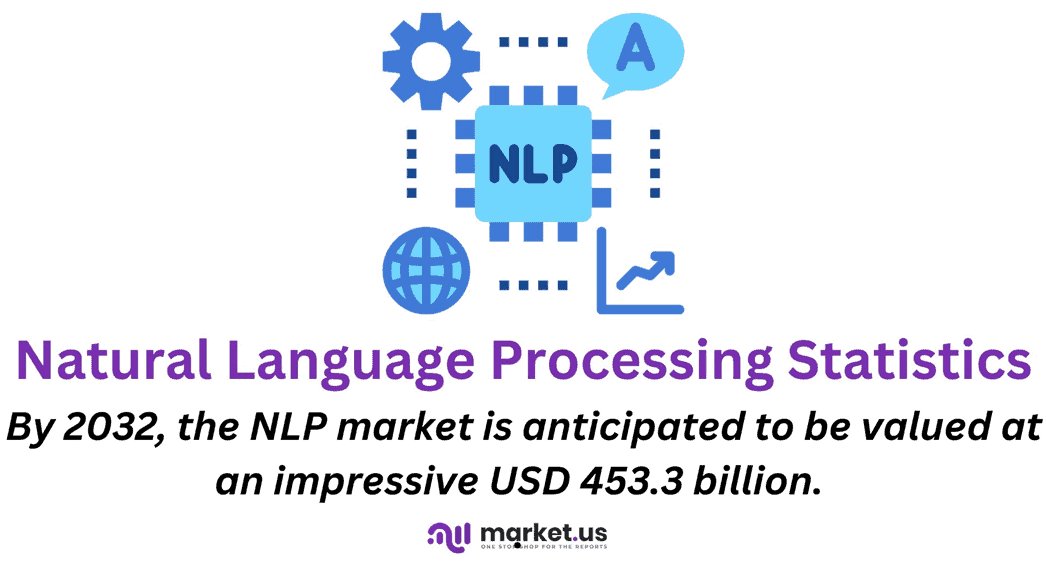
Editor’s Choice
- By 2023, the Natural Language Processing Market revenue is projected to reach USD 37.1 billion, demonstrating a clear upward trend.
- By 2032, the NLP market is anticipated to be valued at an impressive USD 453.3 billion.
- Among several industries, the Business & legal services sector holds the largest share at 26.5%, indicating a significant reliance on NLP technologies in this field.
- The projection is that North America will continue to have the biggest revenue share, making up 30.7% by 2022.
- According to types of NLP, Statistical NLP, Rule-Based NLP, and Hybrid NLP technologies continued to flourish. Contributing USD 178.2 billion, USD 128.7 billion, and USD 146.4 billion, respectively, to the overall revenue.
- According to Chatbot Magazine, implementing NLP-driven predefined functions in the automotive sector could reduce customer support costs by as much as 30 percent.
- The NLP market shows declining growth in 2022, with a growth rate of 36.50%.
- Looking ahead, the projections suggest a gradual slowing of growth. With estimates at 26.50% in 2023, 23% in 2024, and 16% in 2025.
Natural Language Processing Market Statistics
Overview of Market Size
- The natural language processing (NLP) market has been experiencing remarkable growth in recent years. With its revenue steadily increasing at a CAGR of 33.1%.
- In 2022, the NLP market generated USD 27.9 billion in revenue and is expected to grow significantly in the coming years.
- By 2023, the revenue will reach USD 37.1 billion, demonstrating a clear upward trend.
- Looking ahead to 2024, the NLP market is forecasted to continue its impressive growth. With revenue anticipated to reach USD 47.8 billion.
- The market’s growth trajectory becomes even more pronounced in the subsequent years. With revenue estimates of USD 67.8 billion in 2025, USD 93.2 billion in 2026, and USD 120.1 billion in 2027.
- As we move further into the future, the NLP market is expected to experience exponential growth. By 2028, the revenue is projected to surpass the USD 144.5 billion mark; by 2029. It is estimated to reach a substantial USD 192.4 billion.
- The growth trend continues into the next decade. With NLP market revenue expected to soar to USD 247.8 billion in 2030 and a staggering USD 329.9 billion in 2031.
- By 2032, the NLP market is anticipated to be valued at an impressive USD 453.3 billion.
- These projections illustrate NLP technology’s immense potential and significance in various industries, from healthcare to finance. As it reshapes how we interact with and analyze textual data.
(Source: Market.us)
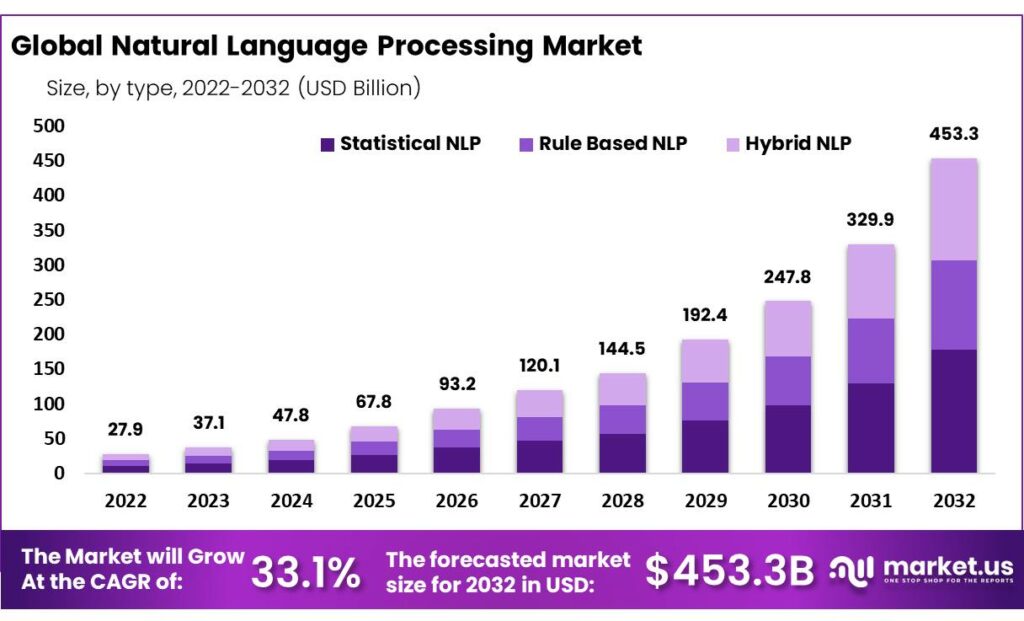
- The Natural Language Processing (NLP) market share is distributed across various industry sectors.
- Among these, the Business & legal services sector holds the largest share at 26.5%. Indicating a significant reliance on NLP technologies in this field.
- Media & entertainment follows closely with a substantial market share of 21.2%. Reflecting the importance of NLP in content creation and delivery.
- The Energy sector contributes 15.01% to the NLP market.
- In comparison, the Healthcare and Finance sectors have notable but slightly smaller shares at 8.86% and 8.25%, respectively. Highlighting their adoption of NLP for applications like healthcare records and financial analysis.
- Security, Transportation, and Retail sectors account for smaller shares of 5.82%, 4.39%, and 4.12%, respectively.
- The remaining sectors comprise 5.86% of the NLP market share, emphasizing the diverse industries benefiting from NLP technologies.
(Source: Statista)
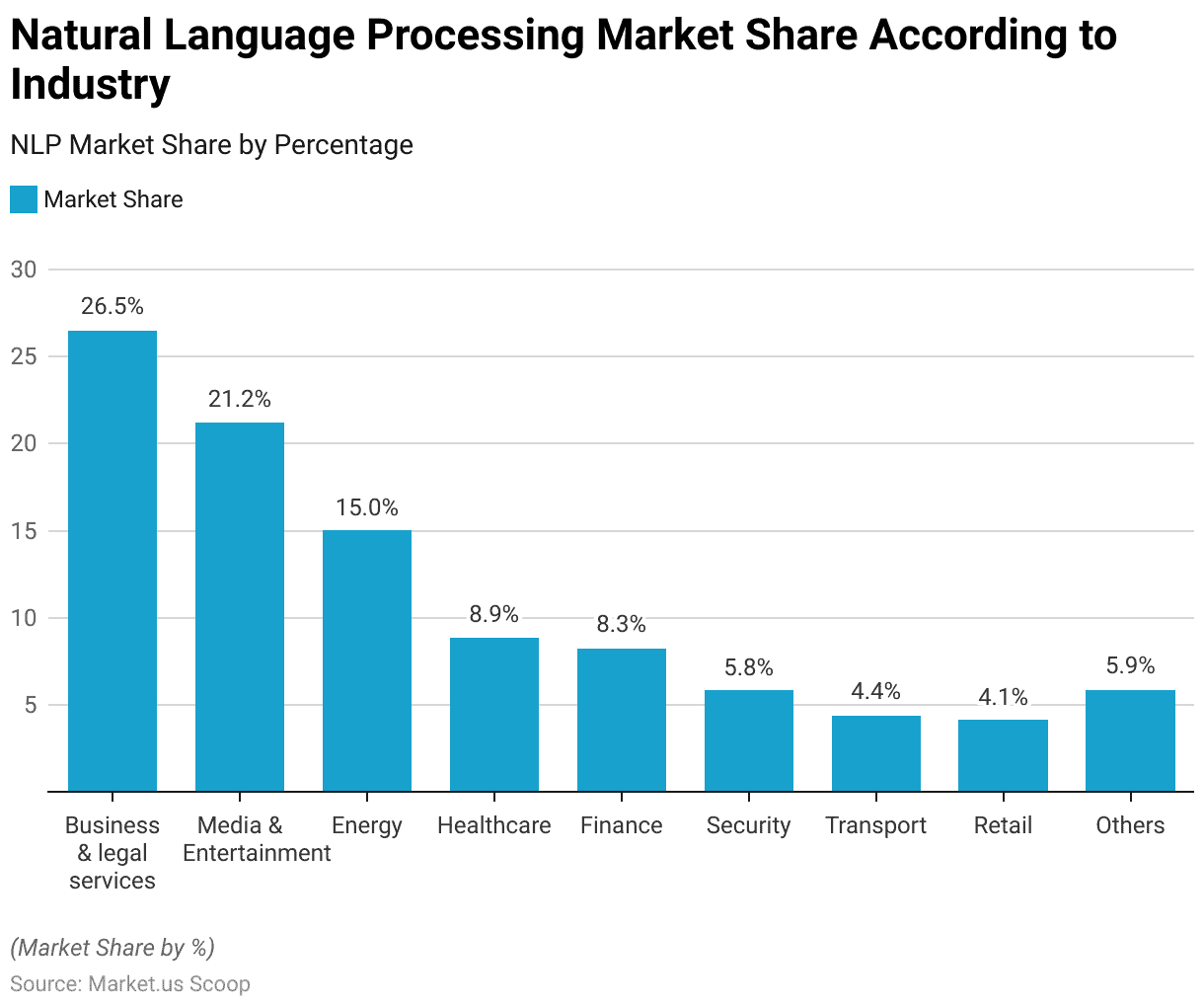
Regional Analysis of Natural Language Processing Market
- The projection is that North America will continue to have the biggest revenue share, making up 30.7% by 2022.
- This is mainly due to the influence of AI and machine learning technologies. Additionally, North America is a significant market for natural language processing services. Thanks to the presence of major players like Microsoft and IBM.
- On the other hand, the Asia Pacific region is expected to experience the highest annual growth rate of 43.2% in the foreseeable future.
- This growth is attributed to increased smartphone usage and rapid technological advancements. The digitalization of economies, and government initiatives in developing nations within the region.
(Source: Market.us)
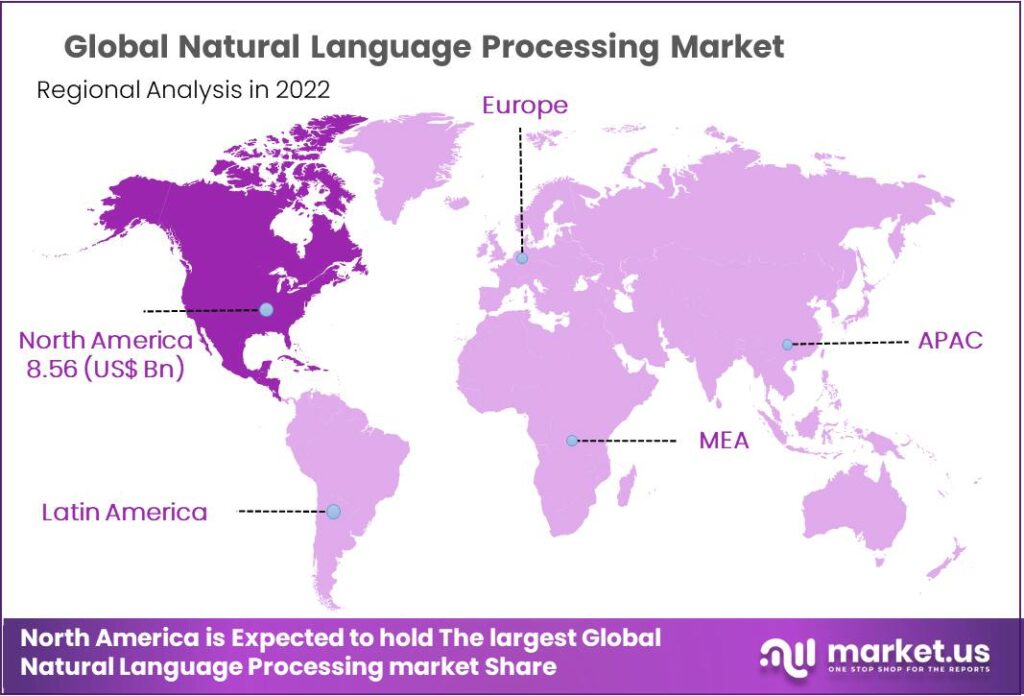
Types of Natural Language Processing Statistics
Natural Language Processing Market Revenue- By Type
- The Natural Language Processing (NLP) market is witnessing impressive growth, as the revenue figures from 2022 to 2032 indicate.
- In 2022, the total revenue in this sector stood at USD 27.9 billion. This revenue was primarily generated from three types of NLP technologies: Statistical NLP, Rule-Based NLP, and Hybrid NLP, contributing USD 11.0 billion, USD 7.9 billion, and USD 9.0 billion, respectively.
- Over the following decade, the NLP market experienced substantial expansion. By 2032, the total revenue had skyrocketed to USD 453.3 billion, marking a remarkable growth trajectory.
- Statistical NLP, Rule-Based NLP, and Hybrid NLP technologies continued flourishing. Contributing USD 178.2 billion, USD 128.7 billion, and USD 146.4 billion to the overall revenue.
- The growth trend was consistent throughout this period, driven by increasing demand for NLP applications in various sectors such as healthcare, finance, customer service, and more.
- Businesses and organizations have increasingly recognized the value of NLP in automating tasks. Improving customer experiences, and gaining valuable insights from unstructured data.
(Source: Market.us)
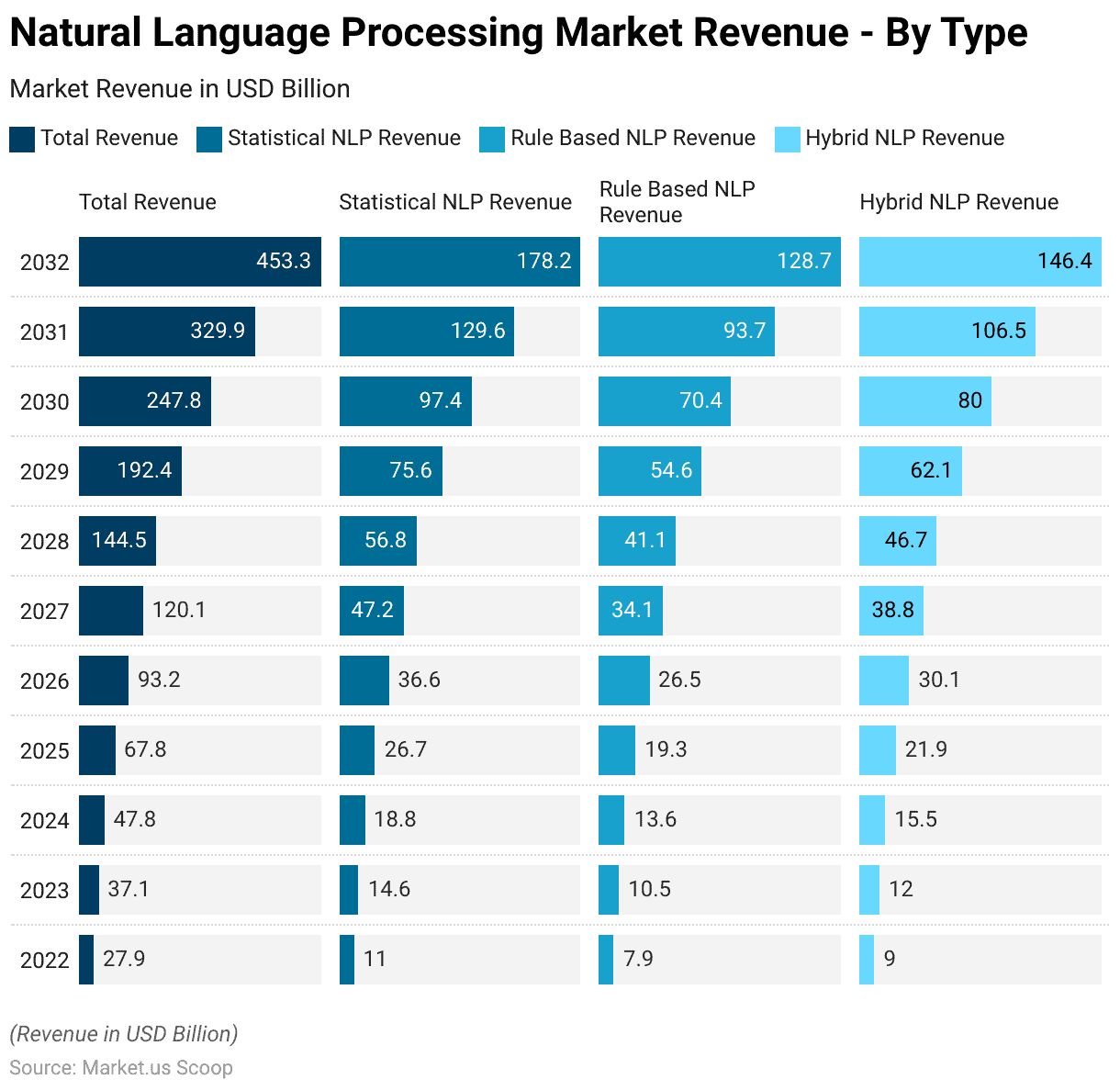
Applications of Natural Language Processing Statistics
Natural Language Processing Market Share- By Application
- The Natural Language Processing (NLP) market is diversifying its impact across various applications, contributing to its overall growth and influence.
- Among these applications, Automatic Summarization holds a notable market share of 18.0%. Signifying its significance in condensing large volumes of text into concise and informative summaries.
- Content Management follows closely with a 17% market share, underlining its role in efficiently organizing and managing textual content.
- Language Scoring and Sentiment Analysis share a similar market share of 15% and 17%, respectively. Showcasing the importance of these applications in evaluating language proficiency and gauging sentiment in text data.
- Data Extraction, with a 10% market share, is vital in extracting structured information from unstructured text, aiding in data analytics and decision-making processes.
- Additionally, the NLP market encompasses a diverse array of Other Applications, which collectively hold a substantial 23% market share.
- These applications span a wide spectrum of uses, further illustrating the versatility and adaptability of NLP technologies to meet various industry-specific needs.
(Source: Market.us)
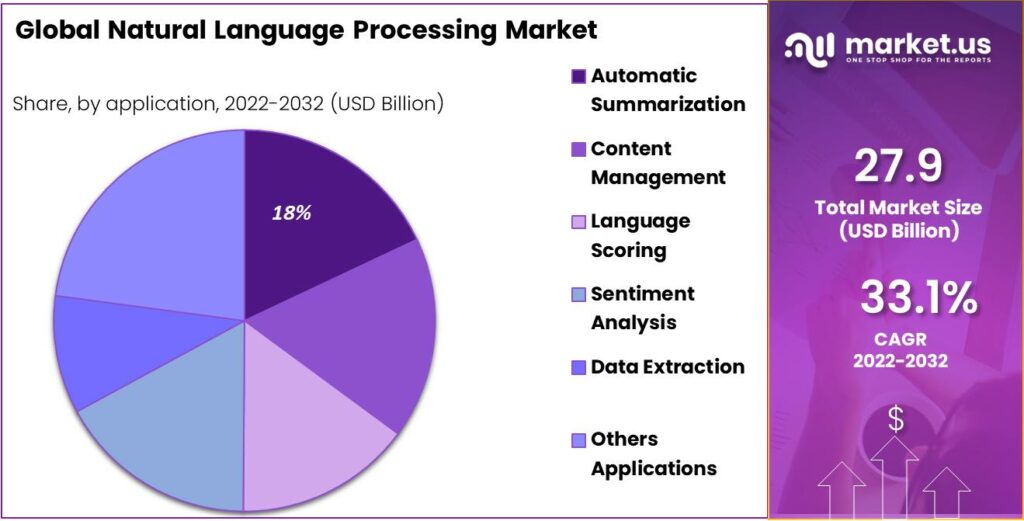
Advantages of Using NLP in Business
- Chatbot Market Size Recorded Sales of USD 6 Billion in 2023. Experienced a CAGR of 23.9% year-on-year growth.
- Computational linguistics and natural language processing can efficiently handle large volumes of data from diverse sources and transform them into actionable insights much faster than a human could.
- For instance, Qualtrics XM Discover can transcribe a thousand hours of audio conversations in just one hour, streamlining the process significantly.
- With the help of chatbots powered by NLP, you can automate everyday repetitive tasks. Resulting in cost and time savings for your company.
- According to Chatbot Magazine, implementing NLP-driven predefined functions in the automotive sector could reduce customer support costs by as much as 30 percent.
- Salesforce found that 69% of proficient service agents actively look for chances to utilize artificial intelligence.
- Conversational AI, through the use of Natural Language Processing (NLP) to convert user queries into computer-readable language. Can handle simple inquiries without demanding much attention.
- This grants agents additional time to address complex questions that necessitate human engagement.
- Based on data from 78% of firms using an AI-enhanced applicant tracking system, it has become easier to locate exceptional employees.
- An AI-powered ATS expedites hiring and allows companies to filter out unsuitable candidates without conducting interviews.
- Chatbot Statistics: A computer program designed to simulate human conversation, utilizing Natural Language Processing (NLP) technology.
(Source: Qualtrics, Salesforce, Brouton Lab, Chatbot Magazine)
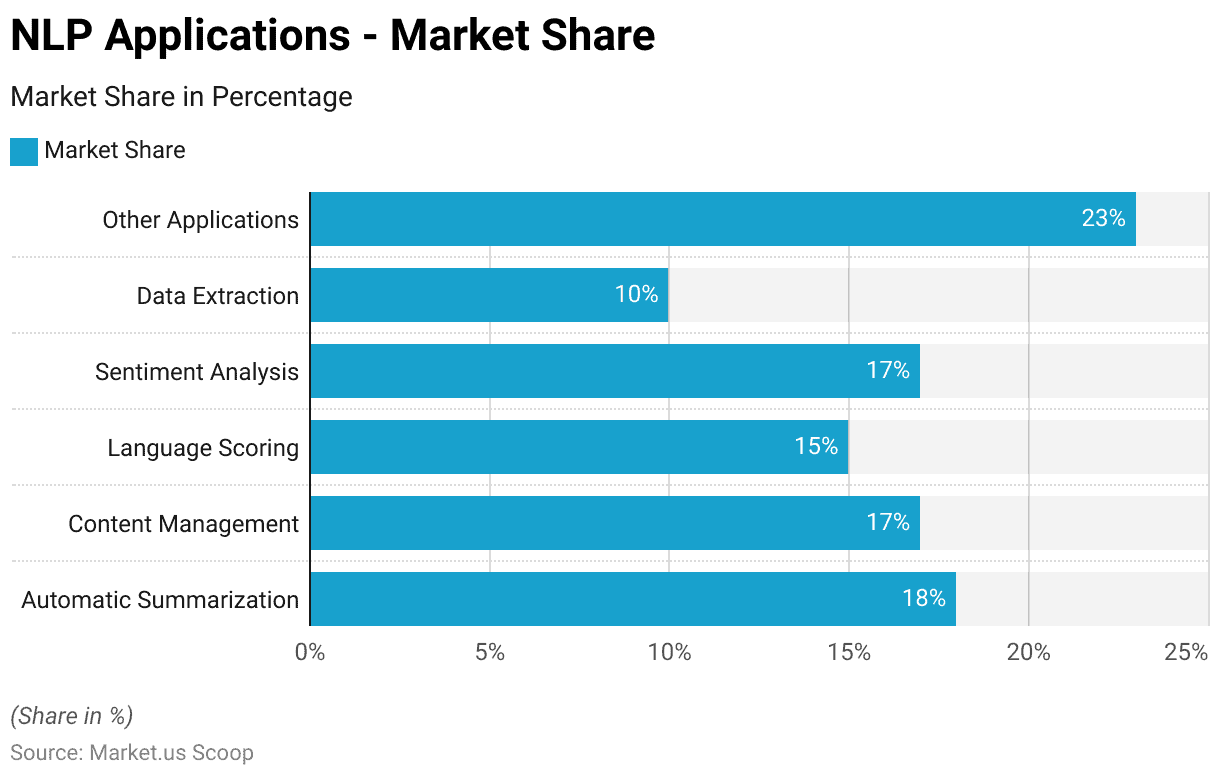
Overview of GPT-3: A Useful NLP Model
- GPT-3, an influential artificial intelligence for natural language processing (NLP), was developed by the non-profit organization OpenAI in Silicon Valley, founded by notable figures including Elon Musk and other regional entrepreneurs.
- GPT-3 utilizes deep learning to generate human-like responses to textual queries and solve problems using natural language.
- The GPT-3 neural network was exposed to an extensive corpus of internet-derived natural language comprising over 500 billion words to ensure comprehensive training with vast information.
- Moreover, this training effort resulted in a model with 175 billion parameters, a significant enhancement compared to its predecessor, GPT-2, which had a mere 1.5 billion parameters, representing a tenfold increase compared to the original GPT model.
(Source: TechTarget)
Companies Statistics Advancing Natural Language Processing
Microsoft
- Microsoft Azure has played a pivotal role in training groundbreaking models developed by OpenAI, and these models are currently deployed within Azure to support leading-edge AI products such as GitHub Copilot, DALL·E 2, and ChatGPT.
- In addition, Azure Cognitive Service for Language provides conversational language comprehension capabilities. Allowing users to create a component that can be integrated into end-to-end conversational applications.
- This program empowers users to develop conversational bots, human-assistant bots for improved customer interactions, and command-and-control applications using speech-to-text functionality and data extraction.
- It offers a clear and business-friendly setup with well-defined guidelines on AI usage.
(Source: Microsoft)
- By leveraging Google’s machine learning capabilities, Google Cloud’s NLP platform empowers individuals to gain insights from unstructured text.
- AutoML simplifies training custom machine learning models for tasks like classification, sentiment analysis, and entity detection using Vertex AI for natural language. All without requiring extensive machine learning expertise.
- Users can easily upload their training data and test custom models through the AutoML user interface, eliminating the need for coding.
- In addition, Google Cloud’s Natural Language API provides the functionality to extract entities from text, perform sentiment analysis, analyze syntax, and categorize text, enhancing text analysis capabilities.
(Source: Google)
Amazon
- Amazon Web Services (AWS) is a globally recognized and extensively utilized cloud platform, providing over 200 fully equipped services from data centers worldwide.
- One of its services, Amazon Comprehend, employs machine learning to discover valuable insights and associations within textual data.
- Practical applications for this service encompass indexing and searching through product reviews, managing legal briefs, and processing financial documents.
(Source: Amazon)
OpenAI
- OpenAI, a company dedicated to AI research and implementation, aims to ensure that artificial general intelligence benefits humanity.
- The launch of OpenAI’s GPT-3 large language model in 2020 marked a significant achievement in natural language processing (NLP).
- Moreover, building upon these advancements, its successor, GPT-4, is a substantial multimodal deep-learning model capable of processing text and image inputs and providing textual outputs.
- As stated by OpenAI, GPT-4 demonstrates performance comparable to that of humans across various professional and academic benchmarks.
- It can be utilized for NLP applications, including text categorization, sentiment assessment, language translation, text generation, and answering questions.
(Source: OpenAI)
Baidu
- By leveraging Baidu Language and Knowledge’s extensive data resources, Baidu focuses on advancing state-of-the-art technologies in natural language processing and knowledge graph development.
- Further, In Natural Language Processing, they have developed several core capabilities and solutions, including more than ten functionalities such as sentiment analysis, address recognition, and customer feedback analysis.
- According to SiliconAngle, Baidu has asserted that its Ernie 3.5 chatbot has already surpassed ChatGPT in terms of comprehensive abilities and has outperformed GPT-4 in proficiency in the Chinese language.
- However, In a mere three months following the beta launch of Ernie Bot, Baidu’s significant language model based on Ernie 3.0 and Ernie 3.5 has seen substantial improvements in effectiveness, functionality, and performance.
(Source: SiliconAngle)
Challenges in the Adoption of NLP & Related Technologies
- Among U.S. businesses, there is a scarce adoption of advanced computer-based technologies. Some technologies are more prevalent than others.
- Among the surveyed businesses, robotics are being used or tested by only 1.2%, with 86% not utilizing them and 13% unsure of their status.
- Automated guided vehicle systems also see limited adoption, with 0.6% in use or testing, 14% unsure, and 86% not using them.
- Further, RFID inventory systems and machine vision software have slightly higher adoption rates, at 1.3%, but still face significant non-adoption and uncertainty.
- Natural language processing is employed or tested by 1.4% of businesses, while voice recognition software has a higher adoption rate at 2.7%.
- Machine learning technology is in use or testing by 2.6% of companies.
- Augmented reality sees adoption among 0.9% of businesses. In contrast, touchscreens and kiosks for customer interfaces are relatively more prevalent, with 6.2% utilizing them.
- Moreover, these statistics indicate a varied landscape of technology adoption among U.S. businesses, with some technologies gaining more traction than others, while many businesses have yet to explore these advanced tools.
(Source: Pew Research Center)
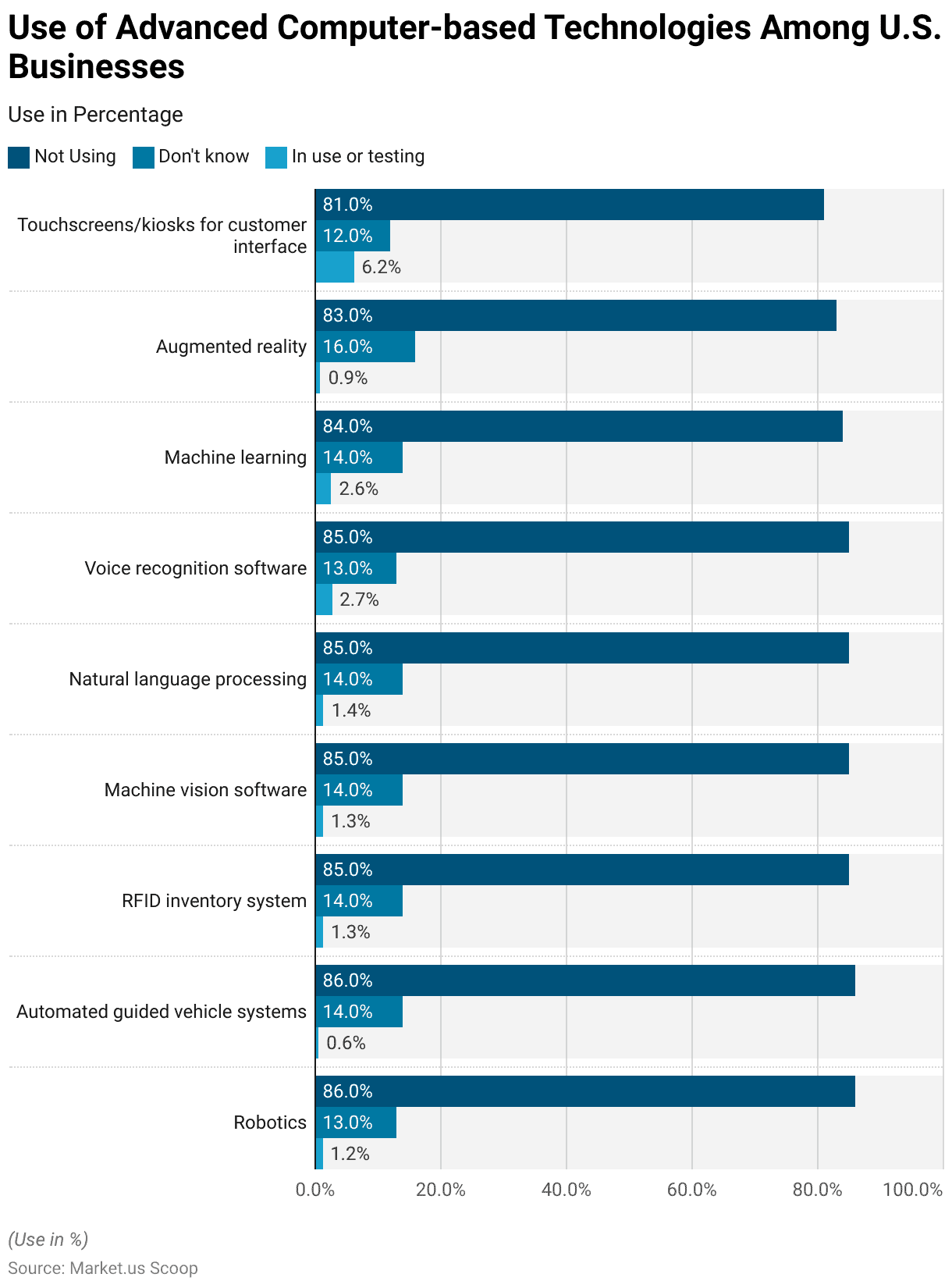
Future Projections of Natural Language Processing Statistics
- The future projections for the Natural Language Processing (NLP) market indicate a changing landscape in terms of year-on-year growth.
- In 2018, the market saw a robust growth rate of 59.30%, which continued to climb in 2019 at 61.80%.
- However, in 2020, there was a slight dip with a growth rate of 51%, followed by a further decrease to 41.80% in 2021.
- The declining growth trend continued into 2022 when the growth rate stood at 36.50%. The projections suggest a gradual slowing of growth, estimated at 26.50% in 2023, 23% in 2024, and 16% in 2025.
- These figures indicate a maturing market where the initial explosive growth stabilizes over time.
(Source: Statista)
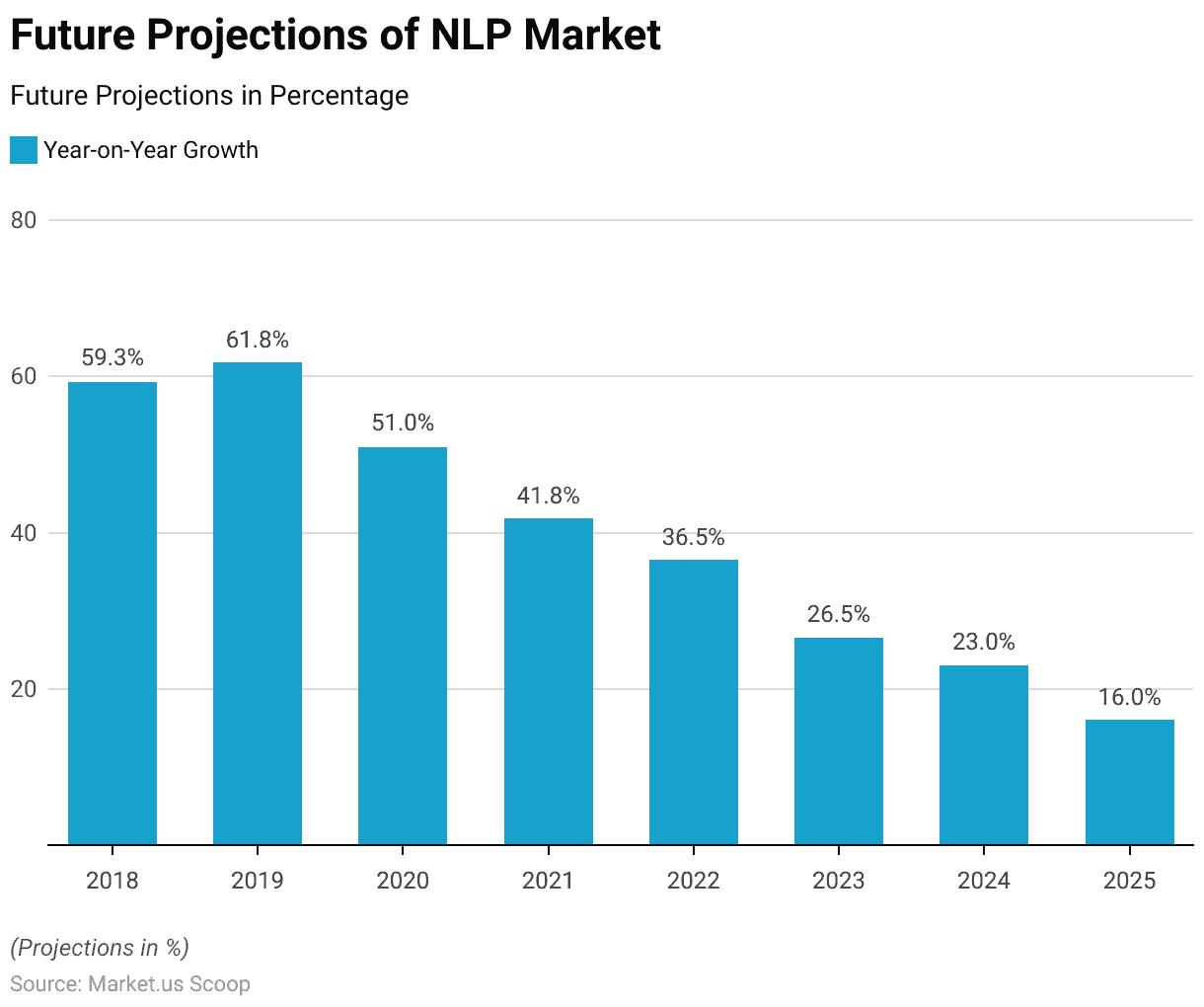
Recent Developments
Acquisitions and Mergers:
- Microsoft acquires Nuance Communications: In 2023, Microsoft completed its acquisition of Nuance Communications, a leader in NLP and AI, for $19.7 billion. This acquisition strengthens Microsoft’s presence in healthcare AI, particularly in speech recognition and clinical documentation through NLP technologies.
- ServiceNow acquires Passage AI: In mid-2023, ServiceNow acquired Passage AI, a company specializing in NLP and conversational AI, for an estimated $150 million. This acquisition is expected to enhance ServiceNow’s virtual agent capabilities and improve natural language understanding in customer service applications.
New Product Launches:
- OpenAI’s GPT-4 Launch: In early 2023, OpenAI launched GPT-4, a state-of-the-art NLP model that improves upon GPT-3 in terms of accuracy, reasoning, and context understanding. GPT-4 is designed for more advanced conversational AI and text generation, offering improvements in tasks like content creation, summarization, and translation.
- Google’s LaMDA Updates: In late 2023, Google rolled out updates to its LaMDA (Language Model for Dialogue Applications) platform, improving its conversational capabilities for natural and human-like interactions. These advancements enhance Google’s AI-driven services, including search and virtual assistant technologies.
Funding:
- Hugging Face secures $100 million: In 2023, Hugging Face, an open-source platform for NLP models and AI tools, raised $100 million in funding to accelerate the development of its machine learning platform. The funding will be used to expand its NLP model offerings and invest in community-driven AI research.
- OpenAI raises $500 million: OpenAI secured $500 million in early 2024 to further develop its NLP and AI models, particularly focusing on commercial applications of GPT-4 and AI-driven language solutions for industries such as healthcare, finance, and customer support.
Technological Advancements:
- Transformer Models: The use of transformer-based models like GPT and BERT continues to dominate the NLP space. Offering superior language understanding and text generation capabilities. By 2024, it is expected that over 50% of NLP applications will leverage transformer models. Given their ability to handle large-scale, contextual language tasks.
- NLP in Healthcare: NLP is increasingly being integrated into healthcare systems to automate clinical documentation, improve patient interactions, and assist in medical research. In 2023, healthcare NLP applications accounted for 20% of the market, and this share is expected to grow with advances in speech recognition and AI-driven diagnostics.
Market Dynamics:
- Growth in the NLP Market: This rapid growth is driven by increasing demand for AI-powered chatbots, virtual assistants, and automated customer service solutions across multiple industries.
- Rising Adoption in Finance: The financial sector is increasingly adopting NLP for risk management, fraud detection, and customer service automation. By 2024, it is estimated that 25% of financial institutions will use NLP-based solutions, especially for sentiment analysis, document processing, and regulatory compliance.
Conclusion
Natural Language Processing Statistics – In summary, Natural Language Processing (NLP) is a leader in technological progress, revolutionizing our interactions with computers and data.
It has developed significantly, becoming a potent tool proficient in comprehending, creating, and processing human language with impressive precision and effectiveness.
Further, NLP’s applications span various industries, encompassing healthcare, finance, customer service, and media, facilitating automation, data analysis, and enhanced user experiences.
While NLP’s ongoing advancement brings both opportunities and challenges, like addressing bias and ensuring ethical use.
Finally, Its future holds immense potential to transform communication, decision-making, and information retrieval in ways yet to be fully grasped. It is a field ripe with possibilities, and its journey of growth and exploration is far from complete.
FAQs
NLP is a branch of artificial intelligence that focuses on enabling computers to understand, interpret, and generate human language meaningfully and usefully.
NLP is used in various applications, including chatbots, sentiment analysis, language translation, speech recognition, text summarization, and information retrieval.
NLP uses algorithms and models to analyze and process text or speech data. It involves tokenization, syntax analysis, semantic analysis, and machine learning techniques to understand and generate human language.
Challenges in NLP include handling ambiguity in language, acquiring large labeled datasets for training, addressing bias in data and models, and dealing with multiple languages and dialects.
Popular NLP tools and libraries include NLTK (Natural Language Toolkit), spaCy, Gensim, Transformers (such as BERT and GPT), and Stanford NLP.
Discuss your needs with our analyst
Please share your requirements with more details so our analyst can check if they can solve your problem(s)



